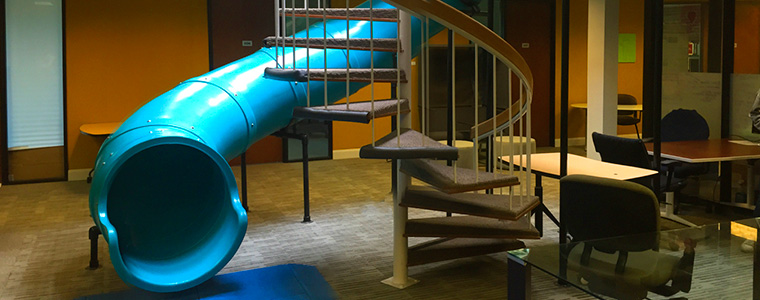When a law firm wants a bouncy castle in their office

by Lauren Gregson
There has been a lot of positive PR in recent years about the fun, innovative workspaces that have been created for the likes of Google, Ticketmaster and countless startups and creative agencies. Offices full of slides, ping pong tables, ball pits and hammocks stand as evidence that a company is vibrant and cutting edge. Though design like this is usually reserved for startups and their ilk, plenty of traditional companies like law firms still want it, which presents an interesting conundrum for office design firms like ours.
With the likes of Google being at the top within their industry, everything they do attracts media attention. Design journals label offices like Google’s as offices of the future and often proclaim that such workspaces foster great workplace culture. What such press fails to include, however, is a contrasting view. Where such creativity can be harnessed for culture and productivity at organizations such as Google, they are a long way from being applicable, or even viable, for companies within non-tech industries where such office design is often ill-advised.
Inspiration alone cannot design your office
Playful office design is so endemic that it’s actually quite hard to find any dissenting opinions. After reading hundreds of articles boasting about the benefits of playful offices, we finally discovered an article to the contrary – “Google has had a negative effect on office design” – where author Jeremy Myerson notes that, “Trying to treat the whole world as though every organization should be like Google is a bit of a bad idea.”
It’s in an innovative company’s nature to be, well, innovative, so naturally Google and other companies deserve credit for their creativity. They’ve created highly relevant workspaces designed to suit their organizational culture. Like their offices, the best spaces not only look great, but are a good fit for the brand, the employees, and the kind of workplace culture they want to foster.
But along the way they’ve inspired a kind of copycat culture within office design. Companies in very disparate industries are now convincing themselves that an appropriate office design should be based on what the cool tech companies are doing, rather than on what they should be doing. In reality, most organizations should not look to Google as an example.
Bespoke workspace design that works smarter
Our organization coined the term “smarter workspace,” a concept which challenges the misconception that the best office design based on the latest trend or the adoption of the latest workplace technology. Instead, when our team approaches office design with clients, the focus is on providing a tailored solution, regardless of what happens to be trending.
Every interior design firm is very different and what works best for them may be completely different to our own approach. But having spoken with numerous commercial interior and design firms across Hertfordshire and London in 2016, I’ve noticed a growing sentiment among us. We agree the industry needs to challenge the notion that offices should be installing table tennis and a pinball machines by default. Certainly they shouldn’t do it just because some other company has one and it’s all over the news. It is misguided to even consider this approach for corporate firms operating within the legal or financial sector. Their cultures contrast too greatly from the tech industry, and with good reason.
While that may seem obvious to some, it’s not obvious to every company. We received an inbound call only a couple of months ago where the client said, “We would like our office to look like Google’s, how can you help?” Thankfully the firm was a tech firm so there was some synergy between who they were and what they wanted. The danger is when far-fetched ideas become so embedded in the public psyche that they become normal expectations. Ultimately, when that happens, we all need to take a step back and consider where to draw the line between what’s fun and what’s practical. Can both be achieved in conjunction? Yes, but only where appropriate.